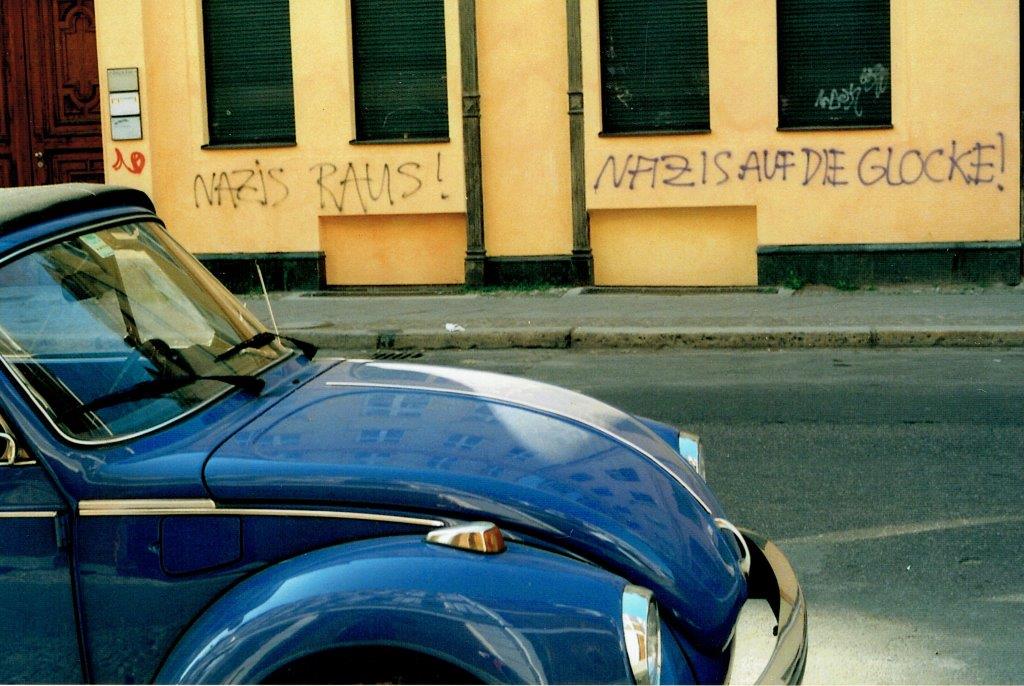Well, I’m not a figure of privilege and leisure, but otherwise I reckon I fit the bill, and reading the article prompted me to dive into another pile to find a wallet of photos I took in 2002 on a work trip to Berlin. It was my first visit, a three day educational development conference on editing alumni magazines. For a history-buff like myself this was a heaven-sent opportunity to see something of a deeply fascinating city. In order to make the most of it, I decided to get up at the crack of dawn each day and walk its streets, a favourite strategy in an unknown place.
I’d arrived courtesy of Lufthansa at the old Tempelhof airport, where the US Air Force hangars were still visible, and was thrilled, in an Indiana Jones moment, to see a Zeppelin airship warming up ready for take-off on one of the runways. I had some time before the introductory seminar to catch the bus to the British Military Cemetery near Charlottenburg. It was established in 1945 as a central burial ground for aircrew and prisoners of war who were interred in the Berlin area and East Germany. About 80% are aircrew, killed in action over Germany, the remainder prisoners of war, and two Southborough men, Edwin Cooper and Cyril Wickens lie buried here.
Early the next morning I visited the old Jewish quarter, easily reachable from my hotel at the northern end of Friedrichstrasse. I walked over the Montbijou Brücke and down streets including Georgenstrasse, Ackerstrasse, Oranienburgerstrasse, Gross Hamburgerstrasse, Koppenplatz and Turstrasse. Whenever I saw a doorway open to an old courtyard, I nipped in and looked round (incurably nosey, ask my husband!). I saw a memorial to Berlin’s Jewish dead, and a lovely little Jewish school right by it. In 2002, there was, just fifteen years after re-unification, a huge amount of building and renovation going on. The array of wonderful old buildings (some in the old East Berlin still pockmarked with bullet-holes from 1945, or with plaster still missing from the bare brick walls) mixed in with the ultra-modern, the Spree meandering through, but underlying it all, for me personally, was the knowledge that while it’s a great and elegant city, in Nazi times it was full of terrible violence, hatred and fear for those daring to oppose the regime.
The next day I walked down to Checkpoint Charlie and beyond, then up via Leipzigerstrasse, Jerusalemstrasse, Hausvogteiplatz and Oberwallstrasse to Unter den Linden, past the German Historical Musem and Lustgarten to the Berliner Dom, where creative beer-drinkers had left an impromptu art piece on the steps of the Cathedral. An old man was doing some early-morning fishing from the Eiserne Brücke. Later that evening I ducked out of a suggested drinking session with colleagues and instead heard a beautiful concert in the Cathedral, which has sublime acoustics, given by a choir from Bonn, of Spiritual Choral Music from the last 300 years.
On my last morning I walked up to the Brandenburg Gate (covered up except for the Quadriga) and back past the Russian Embassy, down to the Marx-Engels Platz (now Schlossplatz I believe), where a woman in shorts roller-bladed round the Platz and down the tree-lined paths beside it. The Neptune Fountain was dry, no doubt a temporary casualty of ongoing works. I bought my son a Russian surplus army beret at the flea-market along Am Kupfergraben, had breakfast at Cafe Chagall, then caught the U-Bahn to Luftbrücke Platz, and walked through the little park, which includes a memorial to those who died in the Berlin Airlift, to Tempelhof, just in time to snap a Zeppelin taking off. Flying home, I knew I would definitely want to return and see more of Berlin.
If you’d like to read more around the subject, some of my other related blogs:
The Casualties of War
Holocaust Memorial Day - Anita Lasker Wallfisch
Berlin in October
Through a Glass, Darkly


 RSS Feed
RSS Feed
